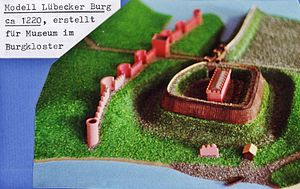Bucu Castle
| Bucu Castle | ||
|---|---|---|
|
Model of the Lübeck Castle around 1220 before the monastery was built ( Trave below , Wakenitz above ) |
||
| Creation time : | presumably 8th century | |
| Castle type : | Niederungsburg, location | |
| Conservation status: | Burgstall | |
| Place: | Lübeck | |
| Geographical location | 53 ° 52 '24.7 " N , 10 ° 41' 21.5" E | |
|
|
||
Bucu is a defunct Slavic castle wall that stood on the site of today's Lübeck castle monastery .
history
Bucu Castle was probably built in the 8th century. After the Slav prince Gottschalk was slain in Lenzen in 1066 , Kruto took over rule in Wagrien after hard fighting . He neglected the place Liubice and concentrated up the Trave on a Werder between Trave and Wakenitz , at the place of the later castle monastery , on the hill fort Bucu. The economic functions were moved from Liubice to the town hill Bucu around 1127. In 1143 Adolf II founded today's city of Lübeck at this point . At the end of the 19th century the peninsula became an island with the construction of the Elbe-Lübeck Canal and the piercing in front of the castle gate with the entire old town of Lübeck .
excavation
In the 1970s, the castle was excavated by archaeologists. The associated settlement, the Suburbium , was uncovered in 1997 by rescue excavations in the street area of the Kleiner Gröpelgrube . The exposed space thus proved that the area east of the castle complex dates from the 8th / 9th century. It was used as a settlement area by Slavs until the middle of the 12th century.
In the southern section of today's Grosse Burgstrasse , a 3.5 m wide and 2.5 m deep ditch protected the settlement. The northern border was probably north of today's Königstrasse. In the west, the settlement was directly connected to the castle, while in the east it reached up to the Wakenitz. All in all, the settlement area thus comprised around 6 hectares. Inside the settlement, some pit houses, fireplaces, pits and, above all, a large number of ceramic finds from two continuous cultural histories were found . The remains of a pottery were found in the Kleiner Gröpelgrube itself . The Slavic pottery tradition was probably able to persist at this point into German times, because in 1297 the Kleine Gröpelgrube (German: Groper = potter) was first mentioned as parva platea lutifigulorum (German: small street of clay potters) .
See also
literature
- Helmolds Chronik der Slaven (= Geschichtschr. D. German prehistoric times 2. Gesammtausg. Vol. LVI ) Translation based on the edition of the Monumenta Germaniae , Leipzig 1894 books - google (PDF; 5.4 MB)

